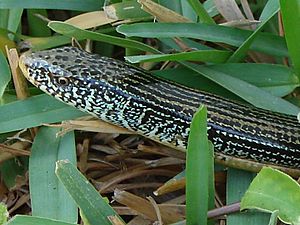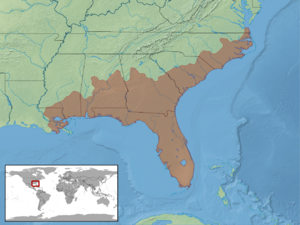Eastern glass lizard facts for kids
Quick facts for kids Eastern glass lizard |
|
|---|---|
 |
|
| Conservation status | |
| Scientific classification | |
| Genus: |
Ophisaurus
|
| Species: |
ventralis
|
 |
|
| Synonyms | |
|
|
The eastern glass lizard (Ophisaurus ventralis) is a fascinating reptile that looks a lot like a snake! But don't be fooled – it's actually a type of legless lizard. These unique creatures live in the Southeastern United States. They are the longest and heaviest of all glass lizards. People often confuse them with snakes because they don't have legs. However, glass lizards have special features that snakes don't, like eyelids that can move and ear openings you can see. They also have a special groove along their side. The name ventralis comes from a Latin word meaning "belly," which refers to how they move, similar to a snake.
Contents
Meet the Eastern Glass Lizard
Eastern glass lizards can grow quite long, up to about 108 centimeters (around 42 inches) in total length. Even though they are long, their main body is only about 30.5 centimeters (12 inches) long. They have a long tail that helps them balance and protect themselves.
You can tell an eastern glass lizard apart from other similar lizards. They don't have dark stripes under their side groove or tail. Also, they don't have a clear stripe down the middle of their back. Older lizards might look greenish on top and yellow underneath. This is the only type of Ophisaurus lizard that can have a green color. Young glass lizards are usually khaki-colored and have two dark stripes running down their back.
Remember, even though they look like snakes, glass lizards have:
- Moveable eyelids (snakes don't blink!)
- Ear openings behind their eyes (snakes don't have outside ears)
- Stiff jaws (snakes have very flexible jaws to swallow big prey)
No different types (subspecies) of the eastern glass lizard are known today.
Where They Live
Eastern glass lizards are often found near wet areas and moist soils. They like flat, open areas next to wetlands with sandy ground. They also need controlled fires to keep their habitat healthy. Sometimes, they are even found in salty coastal areas like sand dunes, because they can handle the salt.
These lizards are most active during the day. You might see them looking for food in open spaces. They also like to hide under things like logs or leaves.
In 2020, scientists found an eastern glass lizard using a crayfish burrow as a home in Mississippi. Many small animals use these burrows, but it was the first time a lizard was seen doing it! This discovery suggests that more lizards might use crayfish burrows than we thought.
Where They Are Found
You can commonly find O. ventralis from the southeastern part of Virginia all the way down to south Florida. They also live west to Louisiana. They mostly stay in the coastal plains of the southeastern United States. The Mississippi River acts like a natural barrier, limiting where they can go. Sometimes, they are even spotted in Oklahoma and Missouri.
What They Eat
Eastern glass lizards are not picky eaters! They will eat almost anything that crosses their path. They are good hunters and use their strong sense of smell and sharp eyesight to find food during the day.
Their diet can include:
- Insects like grasshoppers, crickets, and beetles
- Spiders
- Small mice
- Snails
- Eggs from other reptiles or birds that nest on the ground
- Sometimes, they even eat fruits or plants!
Because their jaws are not flexible like a snake's, they can only eat prey that fits easily into their mouth. They look for food both above ground and in burrows underground.
Staying Safe from Predators
Many animals like to eat eastern glass lizards. Common predators include skunks, raccoons, foxes, snakes, and cats.
Glass lizards have a very cool defense trick called "tail autotomy." This means their tail can break off if a predator grabs it! The detached tail will keep wiggling for several minutes. This distraction helps the lizard escape while the predator is busy with the tail.
How They Reproduce
Eastern glass lizards lay eggs. Females usually lay about 5 to 15 eggs from late April to mid-July. The eggs take about 40 to 65 days to hatch, usually in late summer.
They often lay their eggs under cover or in sandy or soft soil. The mother lizard will coil around her eggs. If someone comes near, she might move away, but she will gather her eggs back together if they get scattered.
Images for kids
-
Eastern glass lizard - Valdosta GA, USA








